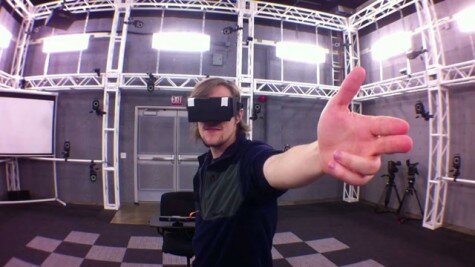“VR to revolutionise spatial storytelling” says James Iliff

"Tezarian Alliance" by Sasha Reneau
3D NEWS> 3D GAMING
Co-developer of Oculus Rift supported Project Holodeck James Iliff, describes three ways virtual reality will change game design.
James identifies the change in peripheral vision (from wearing head mounted displays) as being the most obvious factor which has an interesting effect on how players move: “With tech like the Oculus Rift, the optics actually bend a stereoscopic image around your eyes. So you feel quite a bit more “present” in the game with VR goggles that you would with a television. Because of the presence factor, the sense of space is drastically different, and players move at a slower pace with more deliberation.” He continues: “One funny thing I’ve noticed is that so many first person shooters today still involve a lot of running – the player literally sprints everywhere, traversing large and small environments the same way. But is that really realistic? Why are we always running?
James labels the next fundamental change as “Exploration, Challenge, and Reward.” Rather than short term loops of challenge and reward present in most games (solve a puzzle to open a door for example), he suggests virtual reality gaming will be more likely to reward players with the act of exploration, quoting Dan Pinchbeck, designer of Dear Esther, from EDGE magazine: “Games like Tomb Raider used sweeping vistas and orchestral stings to make exploration a massive reward in it’s own right, and Half-Life did scale in an amazing way – as much as the gunplay, you just wanted to keep exploring Black Mesa…. Virtual reality is going to revolutionise spatial storytelling and exploration, and the inherent reward found in this experience is powerful. However, this doesn’t necessarily mean that traditional game mechanics have to be tossed out the window. They just have to be revamped and redesigned to take advantage of new technology. Traditional feedback loops of challenge and reward can still work well in virtual reality, but it's going to take a lot of development and iteration over the next few years to figure just how ludic interactions can change for the better."

"Ice Mines" by Theo Aretos
Finally, according to James, motion tracking will require new game mechanics and level design techniques to take advantage of the full body avatar style experience: “Tracking the hands and other appendages also changes game design drastically. First of all, it’s really really cool to hold up your hands in the real world, while wearing VR goggles, and see virtual hands in front of your face. This is generally called avatar embodiment, and it gives you a 1:1 representation of your body in the virtual world.”

Firing a handgun in Project Holodeck Wild Skies game
Referring to ‘Wild Skies’ – a game in development for Project Holodeck, James says: “Alex Silkin, lead interaction engineer on the team, has developed code that allows players to pull out guns from their hip, or pull swords from their back, so they can shoot and swashbuckle with pirates in our VR game Wild Skies. For the first time, you can look down the sight of a gun like you would in real life, and the direction of the bullet is determined by how accurate you are actually aiming…This is just one example of the fundamentally different play experience that motion tracking provides. In most first person shooters, there are three different kinds of motion that are usually compressed into a single action: the direction you are looking, the direction you aim your gun, and the direction you are running.”
NEVER MISS A 3D GAMING NEWS STORY – SIGN UP TO THE FREE 3D FOCUS E-LETTER VIA THE RIGHT SIDE BAR
James Iliff is the producer of Project Holodeck and you will be able to watch him present the virtual reality platform at the GAME: NEXT conference in Dublin on December 18th. Read the full Three Fundamental Ways that Virtual Reality is Changing the Future of Game Design by James Iliff post here. For more information about Project Holodeck visit www.projectholodeck.com.
FREE WEEKLY 3D NEWS BULLETIN –



















